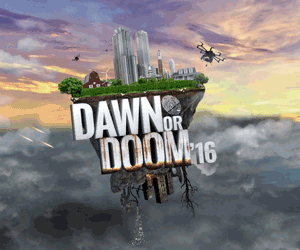September 22, 2016
In the rise of virtual reality there’s potential for both dawn and doom, according to Purdue professor

WEST LAFAYETTE, Ind. – Many people think of virtual reality (VR) as a technology used purely for entertainment, especially in video games. But VR will soon be commonplace in our everyday lives, changing everything from the way we work to the way we connect with other human beings, says David Whittinghill, an associate professor of Computer Graphics Technology and Computer and Information Technology at the Purdue Polytechnic Institute.
The future of VR and some of the changes – both positive and negative – that its integration into our lives may bring will be the subject of a talk given by Whittinghill at Purdue’s Dawn or Doom ’16 conference on the risks and rewards of new technology. The event will be Oct. 3-4, 2016, and is free and open to the public.
For now, a VR user’s headset provides an obvious reminder that he’s not really in the virtual environment. However, physical markers such as headsets and wires will become less noticeable (or disappear) over time and a user will eventually be able to fully substitute a virtual environment for reality, Whittinghill says.
The potential benefits of immersion into a different reality are already becoming clear. VR users feel physical effects based on what they see in a virtual environment, and this has profound implications for the field of health care. For example, immersion in a cold, soothing VR environment can alleviate the considerable pain a burn victim feels during a bandage change. VR can also be used in the psychiatric field to help people overcome phobias with desensitization therapy, by gradually exposing them to the thing they fear.
“Your brain processes information differently in VR than it does, say, reading it in a book,” says Whittinghill, who was drawn to this field because of his background in both computer programming and psychology and an interest in the human side of technology. “The best way to learn something is to do it, and the reason is because our brain encodes that differently in our heads, and it’s ‘sticky’ when we actually do it. VR lets us do things as far as the brain is concerned.”
At the same time, the ability to be fully immersed in a substitute reality is not without potential downsides. The fact that one entity can control another entity’s reality can be troubling in any situation in which there is a power imbalance between the actors, such as in the case of a government and its citizens or an employer and employees. Whereas, now your boss could ask you to watch a video about the company’s values, with VR, she could insert the company’s version of reality into your own reality. Whittinghill also points out that unlike other reality-altering substances like drugs and alcohol, virtual reality is so far completely unregulated.
Nonetheless, Whittinghill stresses that advances in virtual reality are coming no matter what.
“You’re not going to put the genie back in the bottle,” he says. Rather than trying to suppress the technology, Whittinghill suggests that we keep focusing on ways we can do it well and do it in a way that provides societal benefit and not just as a way to exert our will onto others.
Writer: Adrienne Miller, technology writer, Information Technology at Purdue (ITaP), 765-496-8204, mill2027@purdue.edu
Source: David Whittinghill, 765-494-1353, dmwhittinghill@purdue.edu
Note to Journalists: Associate Professor David Whittinghill will be speaking at Dawn or Doom’16 at 11:30 a.m. Tuesday, Oct. 4 in Purdue’s Stewart Center. Press registration is available at http://www.purdue.edu/dawnordoom/Press An animated .gif is available at https://www.purdue.edu/uns/images/2016/dawn-logo.gif

